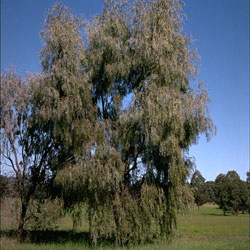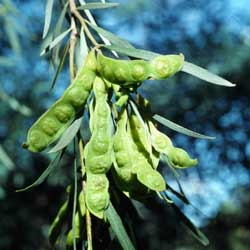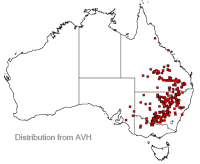Acacia pendula
 |
 |
 |
Weeping Myall, Boree, Nilyah, Balaar
Acacia pendula A.Cunn. ex G.Don
Acacia pendula belongs to the Mimosaceae family: leguminous plants, mostly wattles. Many of the Acacia species are endemic to Australia. Its common names include Weeping Myall, True Myall, Boree, Nilyah and Balaar.
 There are quite a few recognisable characters of Acacias, the main one being that instead of leaves they usually have modified stems called phyllodes, which often look very similar to leaves. They can have many shapes and lengths.
There are quite a few recognisable characters of Acacias, the main one being that instead of leaves they usually have modified stems called phyllodes, which often look very similar to leaves. They can have many shapes and lengths.
Acacia pendula is a spreading or erect tree, growing up to 12m high.
In its native environment, it often grows in alluvial soils (soils that have been washed into by ancient seas, and consisting of sand, gravel, silt and clay). It is also found in relatively heavy clay soils in Victoria. Its habitat (mainly the western side of the Great Dividing Range), gets between 400-600 mm annual rainfall.
It has a number of desirable features.
- Drought tolerant.
- Has a graceful, weeping habit, and striking blue-grey foliage. Because of this, it is also popular in overseas cultivation, including in Iran and Kuwait.
- Will grow in clay soils.
- Is frost tolerant.
- The rhizobium nodules (a feature of all leguminous plants) help in fixing atmospheric nitrogen into the soil.
- Provides good shelter or windbreak.
- It would help to attract native birds to the garden, as parrots eat the seeds.
Propagation is done by seed, which is collected between early October and January. This can be done using the water method of scarification. Put the seeds in very hot water (about 90C) and leave for 24 hours until they appear swollen, then sow them. This seems to be able to break down the tough outer casing. Another method of removing the outer coating (which is virtually waterproof), is by using sandpaper to abrade the surface, but this method isn’t usually used. There is also a microwave method, which involves zapping the seeds for a few seconds instead.
Acacia pendula prefers slightly fertile, well-drained sandy soils, full sun, and occasional watering. However, as a drought tolerant plant, it can survive long periods without watering at all, and will grow in part shade.
Rust (plant disease) produces galls on the phyllodes. With rust fungi the galls can look like worms. Galls can also be produced by insect pests, for example thrips. You can’t really get rid of the rust, as it’s usually systemic in the plant. They leave the plant “stressed” and prevent optimal seed production.
The processionary caterpillars of Ochrogaster contraria, pose a threat to A.pendula, as they will defoliate it. The Bag Shelter Moth, as the name suggests, builds cocoon-type structures out of the leaves of A.pendula. If your skin touches the caterpillars it gets very irritated and itchy. In extreme cases of infestation carbaryl (an insecticide) can be used. This treatment is only worth doing in young plants however. It’s worth noting the moths rarely kill a plant.
Text by Jessica Miller (2007 Botanical Intern)
Name Meaning: Acacia pendulaAcacia – may be from a Greek word meaning to sharpen, referring to the prickly nature of the first species discovered; another opinion refers to the Egyptian thorn (akakia), a species of Acacia which yields gum arabic;. pendula – from “pendere” meaning to fall (Latin). |
References
Orchard, A.E. & Wilson, A.J.G. (eds). (2001). Flora of Australia, Volume 11A & 11B . New South Wales: CSIRO Publishing/ABRS.
Maslin, B. R. (2001). Wattle. Acacias of Australia. Published by the Australian Biological Resources Study, Canberra, and the Department of Conservation and Land Management, Perth. Also available from CSIRO Publishing, Melbourne.
Walsh, N. G. & Entwistle, T. J. (eds) (1996). Flora of Victoria, Volume 3. Royal Botanic Gardens, Melbourne: Inkata Press.
Wrigley, J. W., Fagg, M. (2003). Australian Native Plants. Cultivation Use in Landscaping and Propagation (5 th Edition). Frenchs Forest, New South Wales: Reed New Holland.
Acknowledgements:
Stuart Donaldson, Murray Fagg, Sarah Fethers, Cheryl Backhouse
![An Australian Government Initiative [logo]](/images/austgovt_brown_90px.gif)

